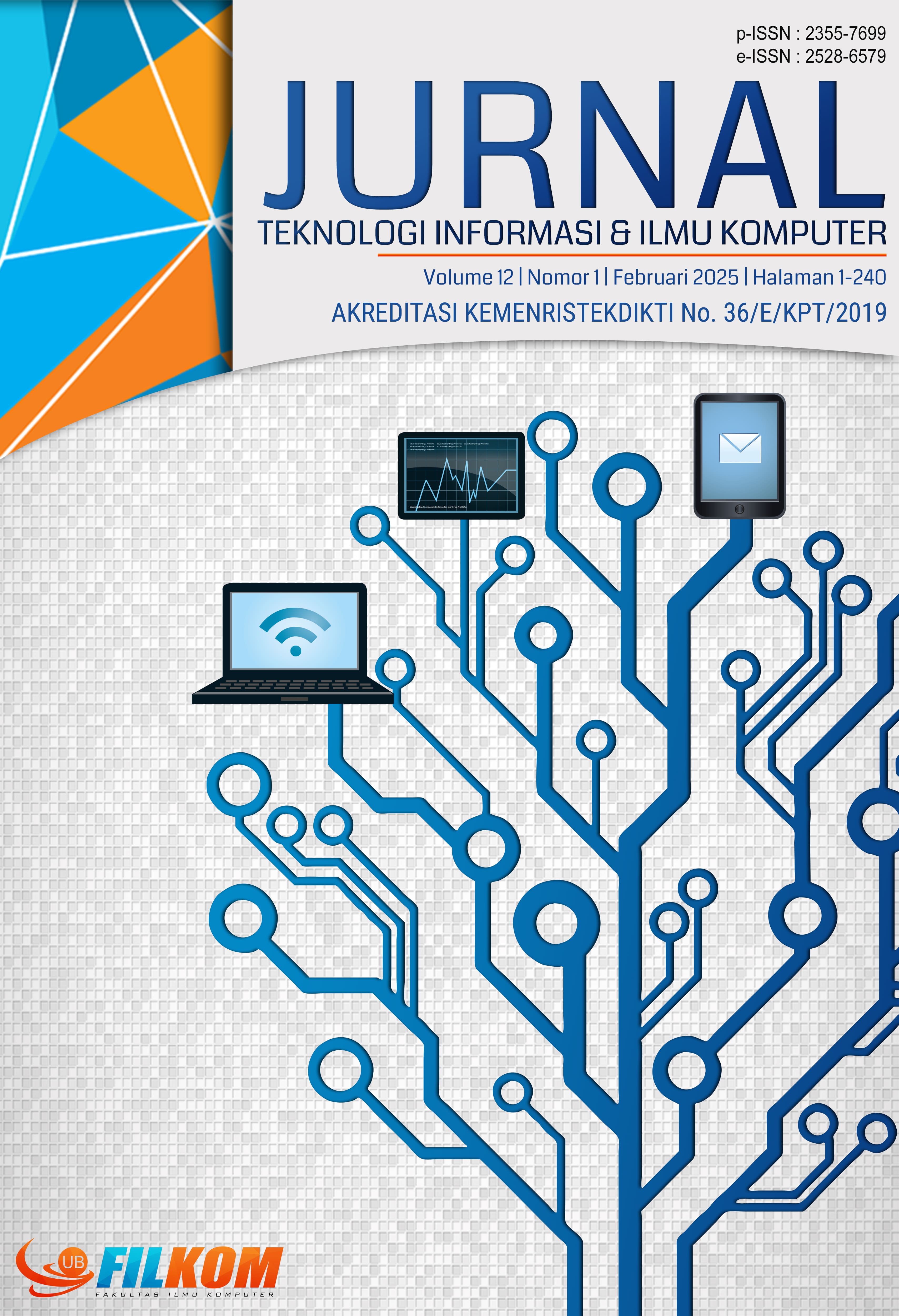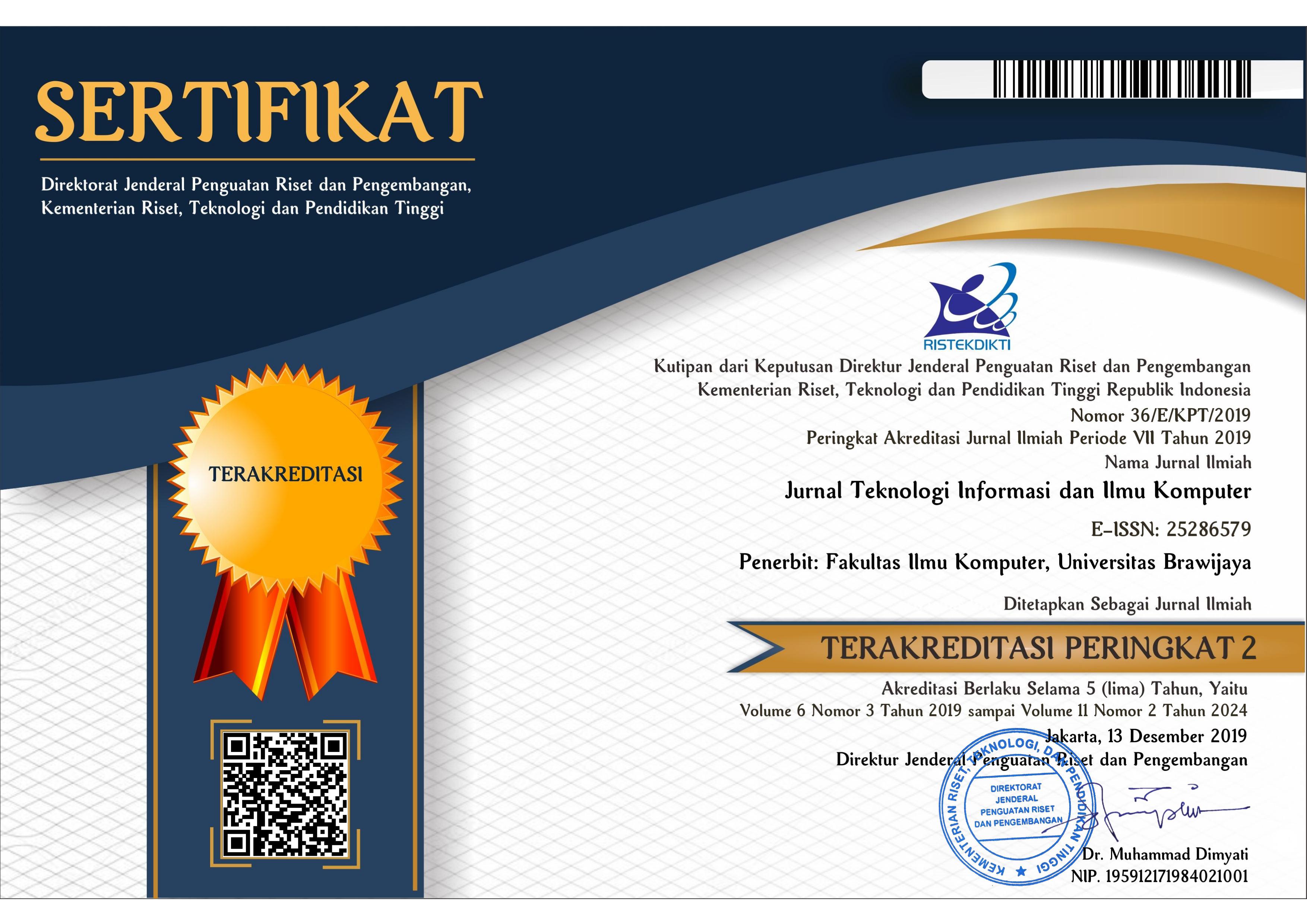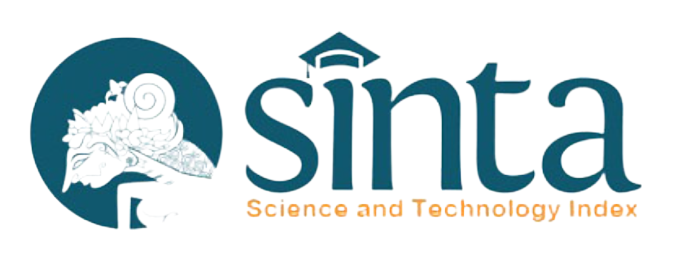LSTM-IOT (LSTM-based IoT) untuk Mengatasi Kehilangan Data Akibat Kegagalan Koneksi
DOI:
https://doi.org/10.25126/jtiik.2025129157Kata Kunci:
LSTM, internet of thing, environment intelligence, nadam optimizer, data sensorAbstrak
Masalah dalam industri terkait kehilangan data suhu dan kelembaban sering terjadi akibat gangguan perangkat atau hilangnya koneksi. Data ini penting untuk menentukan kelayakan produk yang akan didistribusikan. Untuk mengatasi permasalahan tersebut, dikembangkan inovasi LSTM-IOT, yaitu perangkat IoT yang terintegrasi dengan model Long Short-Term Memory (LSTM) dalam arsitektur Environment Intelligence. Arsitektur ini telah dioptimalkan melalui eksperimen menggunakan berbagai jenis optimizer, seperti Adam, RMSprop, AdaGrad, SGD, Nadam, dan Adadelta. Dari hasil optimasi, kombinasi Nadam Optimizer dengan arsitektur terpilih menunjukkan kinerja unggul dengan nilai Mean Square Error (MSE) sebesar 5,844 x10⁻⁵, Mean Absolute Error (MAE) sebesar 0,005971, dan Root Mean Square Error (RMSE) sebesar 0, 007645. Arsitektur Environment Intelligence versi (a) dengan Nadam Optimizer terbukti paling efektif dalam memproses data sensor, sehingga dipilih untuk integrasi dengan perangkat LSTM-IOT. Implementasi LSTM-IOT dalam skenario dunia nyata dilakukan pada wadah web lokal yang memungkinkan akses real-time ke data suhu dan kelembaban di berbagai lokasi. Halaman web berbasis Streamlit ini menampilkan visualisasi data, performa LSTM, dan hasil prediksi. Uji fungsional menunjukkan bahwa LSTM-IOT memenuhi kebutuhan perusahaan, termasuk penyimpanan data dalam database internal serta prediksi kondisi lingkungan hingga 150 menit ke depan. Dengan fitur prediksi dan pemantauan yang canggih, perangkat ini memberikan solusi efisien dan bernilai tinggi bagi perusahaan dalam memantau kondisi lingkungan secara akurat dan proaktif.
Abstract
Problems in the industry related to temperature and humidity data loss are often caused by device interference or loss of connection. This data is important to determine the feasibility of the product to be distributed. To overcome these problems, an LSTM-IOT innovation was developed, namely an IoT device that is integrated with the Long Short-Term Memory (LSTM) model in the Environment Intelligence architecture. This architecture has been optimized through experiments using different types of optimizers, such as Adam, RMSprop, AdaGrad, SGD, Nadam, and Adadelta. From the optimization results, the combination of Nadam Optimizer with the selected architecture shows superior performance with a mean square error (MSE) value of 5.844 x 10⁻⁵, a mean absolute error (MAE) of 0.005971, and a root mean square error (RMSE) of 0.007645. The Environment Intelligence architecture version (a) with Nadam Optimizer proved to be the most effective in processing sensor data, so it was chosen for integration with LSTM-IOT devices. The implementation of LSTM-IOT in real-world scenarios is carried out on a local web container that allows real-time access to temperature and humidity data in various locations. This Streamlit-based webpage displays data visualizations, LSTM performance, and prediction results. Functional tests show that LSTM-IOT meets the needs of the company, including data storage in an internal database and prediction of environmental conditions for up to the next 150 minutes. With advanced prediction and monitoring features, these devices provide efficient and high-value solutions for companies to monitor environmental conditions accurately and proactively.
Downloads
Referensi
ALI, M., SARWAR, T., MUBARAK, N.M., KARRI, R.R., GHALIB, L., BIBI, A. AND & MAZARI, S.A., 2024. Prediction of CO2 solubility in Ionic liquids for CO2 capture using deep learning models. Scientific Reports, [online] 14(1), pp.1–19. https://doi.org/10.1038/s41598-024-65499-y.
BASO, M., MANJANG, S. AND SUYUTI, A., 2024. The Intelligent kWh Export-Import Utilizing Classification Models for Efficiency in Hybrid PLTS. Journal of Applied Data Sciences, 5(2), pp.668–678. https://doi.org/10.47738/jads.v5i2.244.
CHENG, C. AND YUE, W., 2024. Construction of a Green and Low-Carbon Travel Order Prediction Model Based on Shared Bicycle Big Data. International Journal of Computational Intelligence Systems, [online] 17(1). https://doi.org/10.1007/s44196-024-00519-3.
CUI, Y., SHI, X., QIN, Y., WANG, Q., CAO, X., CHE, X., PAN, Y., WANG, B., LEI, M. AND LIU, Y., 2024. Establishment and validation of an interactive artificial intelligence platform to predict postoperative ambulatory status for patients with metastatic spinal disease: a multicenter analysis. International journal of surgery (London, England), 110(5), pp.2738–2756. https://doi.org/10.1097/JS9.0000000000001169.
DHARRAO, D., MR, A., MITAL, R., VENGALI, A., PANGAVHANE, M., RAJPUT, S. AND BONGALE, A.M., 2024. An efficient method for disaster tweets classification using gradient-based optimized convolutional neural networks with BERT embeddings. MethodsX, [online] 13(July), p.102843. https://doi.org/10.1016/j.mex.2024.102843.
DINSA, E.F., DAS, M. & ABEBE, T.U., 2024. AI-based disease category prediction model using symptoms from low-resource Ethiopian language: Afaan Oromo text. Scientific Reports, [online] 14(1), pp.1–15. https://doi.org/10.1038/s41598-024-62278-7.
GANTINI, T., DJAJALAKSANA, Y.M. & YEFTA, S.K., 2018. Pengujian Perangkat Lunak. Journal Universitas STEKOM, [online] 4, pp.1–4. Available at: <https://journal.stekom.ac.id/>.
HIKMAH, H., ASRIRAWAN, A., APRIYANTO, A. & NILAWATI, N., 2023. Peramalan Data Cuaca Ekstrim Indonesia Menggunakan Model ARIMA dan Recurrent Neural Network. Jambura Journal of Mathematics, 5(1). https://doi.org/10.34312/jjom.v5i1.17496.
HU, H., LU, H., SHI, R., FAN, X. & DENG, Z., 2024. A novel fault diagnosis method for key transmission sections based on Nadam-optimized GRU neural network. Electric Power Systems Research, [online] 233(May), p.110522. https://doi.org/10.1016/j.epsr.2024.110522.
KHOLIFATULLAH, B.A.H. & PRIHANTO, A., 2023. Penerapan Metode Long Short Term Memory Untuk Klasifikasi Pada Hate Speech. Journal of Informatics and Computer Science (JINACS), 04, pp.292–297. https://doi.org/10.26740/jinacs.v4n03.p292-297.
KUMAR, Y., GARG, P., MOUDGIL, M.R., SINGH, R., WOŹNIAK, M., SHAFI, J. & IJAZ, M.F., 2024. Enhancing parasitic organism detection in microscopy images through deep learning and fine-tuned optimizer. Scientific Reports, [online] 14(1), pp.1–29. https://doi.org/10.1038/s41598-024-56323-8.
LI, S., TONG, Z. & HAROON, M., 2024. Estimation of transport CO2 emissions using machine learning algorithm. Transportation Research Part D, [online] 133(June), p.104276. https://doi.org/10.1016/j.trd.2024.104276.
MOHAMMED SAAD ASHRAF ALRUBAYE, AZIZAN AS’ARRY, MUHAMMED AMIN AZMAN, MOHD ZUHRI MOHAMED YUSOFF, KHAIRIL ANAS MD REZALI & ALI ZOLFAGHARIAN, 2024. Monitoring and Prediction of Air Quality System using Internet of Things (IoT). Journal of Advanced Research in Applied Sciences and Engineering Technology, 48(1), pp.61–76. https://doi.org/10.37934/araset.48.1.6176.
MUHAMMAD SYUKRI SULIAMAN, ADAM SAMSUDIN, MUHAMAD FALIHAN BAHARI, NOR HAFIZAH HUSSIN, NUR AZURA NOOR AZHUAN, NURUL HAJAR MOHD YUSSOFF, NORHAYATI ROSLI & IRIANTO IRIANTO, 2024. Development of Automated Exhaust Fan for Modern Kitchen with IoT Notification System. Journal of Advanced Research in Applied Mechanics, 120(1), pp.99–109.
https://doi.org/10.37934/aram.120.1.99109.
NÁPOLES-DUARTE, J.M., BISWAS, A., PARKER, M.I., PALOMARES-BAEZ, J.P., CHÁVEZ-ROJO, M.A. & RODRÍGUEZ-VALDEZ, L.M., 2022. Stmol: A component for building interactive molecular visualizations within streamlit web-applications. Frontiers in Molecular Biosciences, 9(September), pp.1–10.
https://doi.org/10.3389/fmolb.2022.990846.
PARHUSIP, H.A., TRIHANDARU, S., RUMAKSARI, A.N., PUSPITASARI, M.D., HARYADI, A.H. & SANTOSA, P.P., 2022. Integrated Sensors into Artificial IntelligenceMining(AI-Mining) Data Acquisition of Environmental Features. International Interdisciplinary Humanitarian Conference for Sustainability, IIHC 2022 - Proceedings, pp.532–539. https://doi.org/10.1109/IIHC55949.2022.10060158.
PRASAD, S., GUPTA, H. & GHOSH, A., 2024. Leveraging the Potential of Large Language Models. Informatica (Slovenia), 48(8), pp.1–16. https://doi.org/10.31449/inf.v48i8.5635.
PURNOWO, D., SETIAWAN, A. & YUSMANIAR, Y., 2024. Pengaruh Faktor Suhu dan Kelembaban pada Lingkungan Kerja terhadap Pertumbuhan dan Perkembangan Mikroba. JRSKT - Jurnal Riset Sains dan Kimia Terapan, 9(2), pp.45–54. https://doi.org/10.21009/jrskt.092.01.
PURWANTO, H., HERMAWAN, M., NAINGGOLAN, C. & WIBOWO, B., 2024. Design of an Automatic Temperature Recorder for Fishery Vessels Using Internet of Things Technology. Journal of Applied Engineering and Technological Science, 5(2), pp.1020–1050. https://doi.org/10.37385/jaets.v5i2.4887.
RAMAKRISHNAIAH, V.K.H., LAKSHMAPPA, H., GURURAJ, B., MUNIYAPPA, R., SIDDARAMAIAH, P.G. AND BYLAMURTHY, N.H., 2024. A novel smart irrigation framework with timing allocation using solenoid valves and Arduino microcontroller. International Journal of Reconfigurable and Embedded Systems (IJRES), 13(3), p.758. https://doi.org/10.11591/ijres.v13.i3.pp758-766.
RAWAT, B., PURNAMA, S. AND MULYATI, 2021. MySQL Database Management System (DBMS) On FTP Site LAPAN Bandung. International Journal of Cyber and IT Service Management (IJCITSM), [online] 1(2), pp.173–179. https://doi.org/10.34306/ijcitsm.v1i1.47.
RIZAL, H.M., WARNI, E., ANGRIAWAN, R., HARIADI, M., ARIF, Y.M. & MAULINA, D. 2024. Design of Flood Early Detection Based on the Internet of Things and Decision Support System. Ingenierie des Systemes d’Information, 29(3), pp.1183–1193. https://doi.org/10.18280/isi.290335.
SALMAN, A.G., HERYADI, Y., ABDURAHMAN, E. AND SUPARTA, W., 2018. Single Layer & Multi-layer Long Short-Term Memory (LSTM) Model with Intermediate Variables for Weather Forecasting. Procedia Computer Science, [online] 135, pp.89–98. https://doi.org/10.1016/j.procs.2018.08.153.
SUFIAN, M.A., HAMZI, W., ZAMAN, S., ALSADDER, L., HAMZI, B., VARADARAJAN, J. & AZAD, M.A.K., 2024. Enhancing Clinical Validation for Early Cardiovascular Disease Prediction through Simulation, AI, and Web Technology. Diagnostics, 14(12), pp.1–44. https://doi.org/10.3390/diagnostics14121308.
SUSILAWATI, S., SUSENO, S. & ROZIKIN, C., 2020. Sistem Monitoring Suhu Dan Kelembaban Ruang Produksi Berbasis Wireless Sensor Network Pada Pt. Xxx Manufacturing Services Indonesia. JUST IT : Jurnal Sistem Informasi, Teknologi Informasi dan Komputer, 10(2), p.136. https://doi.org/10.24853/justit.10.2.136-143.
TAIB, S.A.T., ABU, N., SENAWI, A. & GO, C.K., 2025. The Implementation of Long-Short Term Memory for Tourism Industry in Malaysia. Journal of Advanced Research in Applied Sciences and Engineering Technology, 46(2), pp.90–97. https://doi.org/10.37934/araset.46.2.9097.
TEH, H.Y., KEMPA-LIEHR, A.W. & WANG, K.I.K., 2020. Sensor data quality: a systematic review. Journal of Big Data, [online] 7(1), pp.1–49. https://doi.org/10.1186/s40537-020-0285-1.
VERIANTO, E., 2024. Mencegah Overfitting Pada Model Prediksi. Jurnal Sistem Informasi dan Sistem Komputer, 9(2), pp.195–204.
WAHYUDI, J., ASBARI, M., SASONO, I., PRAMONO, T. & NOVITASARI, D., 2022. Database management in MySQL. Edumaspul - Jurnal Pendidikan, 6(2), pp.2413–2417.
YALAMANCHILI, A., VENKATASEKHAR, D. & KUMAR, G.V., 2023. Attn _ CNN _ LSTM : IoT-Based Automated Alzheimer ’ s Disease Classification using Deep Learning Approach. International Journal of Engineering Trends and Technology, 71(7), pp.132–146.
YU, M., XU, F., HU, W., SUN, J. & CERVONE, G., 2021. Using Long Short-Term Memory (LSTM) and Internet of Things (IoT) for Localized Surface Temperature Forecasting in an Urban Environment. IEEE Access, 9, pp.137406–137418. https://doi.org/10.1109/ACCESS.2021.3116809.
Unduhan
Diterbitkan
Terbitan
Bagian
Lisensi
Hak Cipta (c) 2025 Jurnal Teknologi Informasi dan Ilmu Komputer

Artikel ini berlisensiCreative Commons Attribution-ShareAlike 4.0 International License.

Artikel ini berlisensi Creative Common Attribution-ShareAlike 4.0 International (CC BY-SA 4.0)
Penulis yang menerbitkan di jurnal ini menyetujui ketentuan berikut:
- Penulis menyimpan hak cipta dan memberikan jurnal hak penerbitan pertama naskah secara simultan dengan lisensi di bawah Creative Common Attribution-ShareAlike 4.0 International (CC BY-SA 4.0) yang mengizinkan orang lain untuk berbagi pekerjaan dengan sebuah pernyataan kepenulisan pekerjaan dan penerbitan awal di jurnal ini.
- Penulis bisa memasukkan ke dalam penyusunan kontraktual tambahan terpisah untuk distribusi non ekslusif versi kaya terbitan jurnal (contoh: mempostingnya ke repositori institusional atau menerbitkannya dalam sebuah buku), dengan pengakuan penerbitan awalnya di jurnal ini.
- Penulis diizinkan dan didorong untuk mem-posting karya mereka online (contoh: di repositori institusional atau di website mereka) sebelum dan selama proses penyerahan, karena dapat mengarahkan ke pertukaran produktif, seperti halnya sitiran yang lebih awal dan lebih hebat dari karya yang diterbitkan. (Lihat Efek Akses Terbuka).














